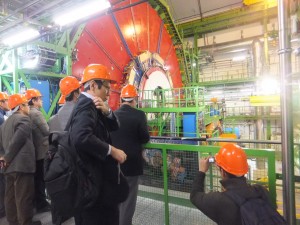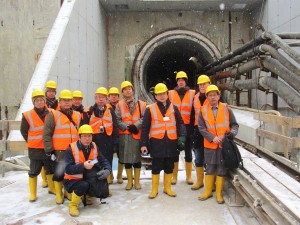Ten members from the Japanese Society for Civil Engineering’s committee for civil works for future ILC facilities came to Europe in February to look at current civil engineering projects like CERN’s LINAC4 and the European XFEL in Hamburg and to discuss administrative challenges. By the end of March next year, the committee will publish draft guidelines on civil solutions for a potential ILC in Japan.

The Japanese visitors inspected the CMS cavern from a civil engineering point of view. Image: Masanobu Miyahara
A committee on civil works for the ILC facilities in Japan was set up by the Rock Mechanics and Tunnel Engineering Committees of the Japan Society of Civil Engineering in 2006. In the past the committee studied four sample sites for the ILC in Japan as well as problems and solutions for the underground ILC facilities. In March 2010 the committee started to work out guidelines for the underground ILC facilities in Japan. Currently the committee consists of more than fifty engineers and scientists affiliated with universities, institutes, construction and consultancy companies concerned with major underground facilities in Japan. The leader of the committee is Professor Hiroshi Chikahisa, Director of the Geotechnical Engineering Division at the Yamaguchi University in South Japan. Masanobu Miyahara (KEK) from the GDE Conventional Facilities and Siting group is also member of this committee. A first draft guideline will be completed by March 2013 and an interim report by March of this year.
In February, ten committee members visited CERN in Geneva, Switzerland and DESY in Hamburg, Germany for one day each. They wanted to find out more about the underground activities at both places and the current state of the ongoing projects.
After the visitors were welcomed by CERN Director General Rolf Heuer and Emmanuel Tsesmelis from International Relations, the morning session concentrated on lessons learnt during the recent LHC civil engineering works. John Osborne from CERN’s civil engineering group explained how the LHC worksites were organised and highlighted some of the problems encountered during the works. Discussions concentrated on both technical and contractual challenges that were overcome. Plans for CLIC and ILC at CERN were also reviewed.
In the afternoon, the party first visited the recently completed LINAC4 injection complex, including the 150 metres of new tunnel that was constructed using the ‘cut and cover’ technique. Subsequently, and due to fact that the LHC was on a ‘technical stop’, the visitors were lucky enough to have access to the CMS underground complex, where many civil engineering challenges were overcome during construction, for example, water ingress and unexpected ground movements. Of particular interest was the 2000-tonne CMS concrete cover on top of the experimental shaft, which is very similar to the proposed platforms that will be used to ‘push-pull’ the ILC detectors.

JSC committee members in front of a photon beam line tunnel portal. Masanobu Miyahara at the right and the committee leader professor Chikahisa are beside the two DESY guides Wilhelm Bialowons and Frank Lehner. The piping for the bentonite can be seen on the right side. (By the way: just after taking this photo the snow stopped falling and the sun started shining, as it mostly does in Hamburg…). Image: Hans-Joachim Christ, DESY
In Hamburg the group received a short introduction and then visited the European XFEL construction area in Schenefeld. The excavation of the pit for the experimental hall made by slurry walls and an underwater concrete slab is already finished. The whole volume dives into the water table. Therefore the basement is fixed by several hundred friction anchors in the ground and the walls are stabilised by a grid of concrete beams. The group could go downstairs to the slab and get an impression of the size of the hall. Final construction is on the way and the tunnel boring of the last of five photon beam line tunnels could be observed. The tunnel is bored by a tunnel boring machine (TBM) and lined with precast watertight concrete segments. The TBM cutting head rotates in a compartment filled with a pressured liquid called bentonite. The bentonite suspension resists the soil and hydraulic pressure to avoid displacements at the surface. The liquid also transports the soil to be separated above ground in centrifuges. Within the steel cylinder behind the head (called the shield) a complete tunnel ring is assembled from the precast concrete segments. The group could look into the tunnel and was able to observe the supply of the machine with precast segments and liquid concrete for the filling of the ring slit between the tunnel and the soil. In the afternoon the XFEL mock-up tunnel and the HERA hall West was on the agenda. At the end of the day DESY and XFEL experts discussed dozens of questions asked by the committee.
The visits to CERN and DESY proved very fruitful, and many ideas and lessons learnt were taken on board for serious consideration by the JSC team developing a technical guideline for the ILC in Japan. Professor Chikahisa expressed his hope that this communication will be mutually beneficial.

Recent Comments